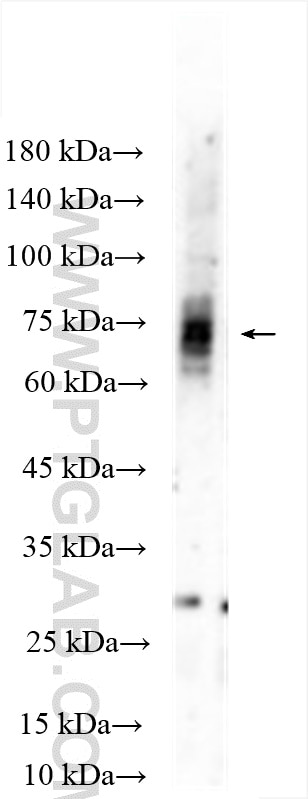- Phare
- Validé par KD/KO
Anticorps Polyclonal de lapin anti-DRD1
DRD1 Polyclonal Antibody for WB, IF-Fro, ELISA
Hôte / Isotype
Lapin / IgG
Réactivité testée
Humain, rat, souris
Applications
WB, IF-Fro, ELISA
Conjugaison
Non conjugué
N° de cat : 17934-1-AP
Synonymes
Galerie de données de validation
Applications testées
| Résultats positifs en WB | tissu cérébral de souris incubé à 37 °C, |
| Résultats positifs en IF-Fro | tissu cérébral de souris, |
Dilution recommandée
| Application | Dilution |
|---|---|
| Western Blot (WB) | WB : 1:500-1:2000 |
| Immunofluorescence (IF)-FRO | IF-FRO : 1:200-1:800 |
| It is recommended that this reagent should be titrated in each testing system to obtain optimal results. | |
| Sample-dependent, check data in validation data gallery | |
Applications publiées
| KD/KO | See 1 publications below |
| WB | See 15 publications below |
| IF | See 6 publications below |
Informations sur le produit
17934-1-AP cible DRD1 dans les applications de WB, IF-Fro, ELISA et montre une réactivité avec des échantillons Humain, rat, souris
| Réactivité | Humain, rat, souris |
| Réactivité citée | rat, Humain, souris |
| Hôte / Isotype | Lapin / IgG |
| Clonalité | Polyclonal |
| Type | Anticorps |
| Immunogène | DRD1 Protéine recombinante Ag12366 |
| Nom complet | dopamine receptor D1 |
| Masse moléculaire calculée | 446 aa, 49 kDa |
| Poids moléculaire observé | 50-75 kDa |
| Numéro d’acquisition GenBank | BC074978 |
| Symbole du gène | DRD1 |
| Identification du gène (NCBI) | 1812 |
| Conjugaison | Non conjugué |
| Forme | Liquide |
| Méthode de purification | Purification par affinité contre l'antigène |
| Tampon de stockage | PBS with 0.02% sodium azide and 50% glycerol |
| Conditions de stockage | Stocker à -20°C. Stable pendant un an après l'expédition. L'aliquotage n'est pas nécessaire pour le stockage à -20oC Les 20ul contiennent 0,1% de BSA. |
Informations générales
Dopamine is a neurotransmitter that plays a crucial role in physical and mental health, such as cardiovascular, hormonal, renal, and central nervous systems (PMID: 29220802). Five subtypes of mammalian dopamine receptors are grouped into two classes, the D1- and D2-like classes. The D1-like class includes D1 and D5 receptors whereas the D2-like class includes D2, D3, D4 subtypes (PMID: 9457173). Dopamine receptor D1 (DRD1) is the most abundant form of dopamine receptor in the central nervous system. DRD1 stimulates adenylate cyclase, modulates D2 receptor activity, regulates neuron growth and differentiation, and mediates several behavioral responses (PMID: 1977312). DRD1 has a calculated molecular weight of 49 kDa, larger apparent molecular weight of 60-80 kDa may be due to glycosylation (PMID: 1281547; 23821371).
Protocole
| Product Specific Protocols | |
|---|---|
| WB protocol for DRD1 antibody 17934-1-AP | Download protocol |
| IF protocol for DRD1 antibody 17934-1-AP | Download protocol |
| Standard Protocols | |
|---|---|
| Click here to view our Standard Protocols |
Publications
| Species | Application | Title |
|---|---|---|
Nat Commun Non-canonical interplay between glutamatergic NMDA and dopamine receptors shapes synaptogenesis | ||
EMBO Mol Med MicroRNA expression profile and functional analysis reveal that miR-382 is a critical novel gene of alcohol addiction. | ||
Elife The organic cation transporter 2 regulates dopamine D1 receptor signaling at the Golgi apparatus. | ||
J Affect Disord Pramipexole improves depression-like behavior in diabetes mellitus with depression rats by inhibiting NLRP3 inflammasome-mediated neuroinflammation and preventing impaired neuroplasticity | ||
Int J Mol Sci Effects of Maternal High-Fructose Diet on Long Non-Coding RNAs and Anxiety-like Behaviors in Offspring |



